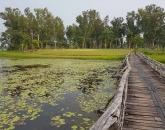
It all started with some whispers about a stunning new course being built on the outskirts of the tiny Oregon town of Bandon. Where? By the time Bandon Dunes opened, rumours were again swirling about a second, even better course called Pacific Dunes. By the time word got out about a third, Bandon Trails, and then a fourth course, Old Macdonald, most serious golfers from our part of the world had at least heard of Bandon Dunes Golf Resort, but relatively few had ever been there. There are now over 90 holes built in this remote spot, and we felt it was time to go and see what all the fuss was about.
That was easier said than done. Part of the allure of Bandon is the difficulty of getting there. Suffice to say San Francisco is the best hopping off point, and it was from there that a friend and I flew. After an unfortunate delay and an even more unfortunate lost bag (both of which I learned is pretty much par for the course – see sidebar), we arrived at the Southwest Oregon Regional Airport at North Bend and took the 25-minute shuttle bus journey to the resort.
By now I was steeped in Bandon lore: how a greeting card salesman, Mike Keiser, without a commercial thought in his head, had stumbled upon some wild linksland and had hired a completely unknown Scot, David McLay Kidd, to design and build a traditional links course. It sounds fanciful because it is.
Keiser had built a billion-dollar company called Recycled Paper Greetings, the second biggest greetings card company in the world. He was hardly a salesman. In addition, he had already embarked on purist golf course construction some time before, with the acclaimed Dunes Club course near Chicago in 1985. He was also a founder at another noted “wilderness” project, the highly rated Sand Hills Golf Club in Nebraska, built by Bill Coore and Ben Crenshaw in 1990.
Furthermore, Kidd, the little-known architect, was the son of legendary greenkeeper Jimmy McLay Kidd of Gleneagles and they originally came as a team before ill health forced Jimmy to take a step back. That said, it was a bold move to take the Kidds in the first place and David has since gone on to build his own flourishing course design business. As for “stumbling” over some land, Oregon was explicitly chosen as having high potential and the search along the coastline went on for some time. In the end it was largely due to the organisational and negotiating skills, and sheer tenacity, of Kaiser’s colleague, the late Howard McKee that the originally protected land was acquired in 1989 and converted to golf use, with the first course opening almost a decade later.
Even the “uncommercial” tag is nonsense. Kaiser and his team set out to build the purest golf destination in the world and did so with a view to making it profit-making from the start. In its first year, Bandon needed 12,000 rounds to break even. They sold 23,000. Simply put, Bandon is a brilliantly run and highly successful operation, a shining example to all in terms of how to do it right.
Pages
Click here to see the published article.











